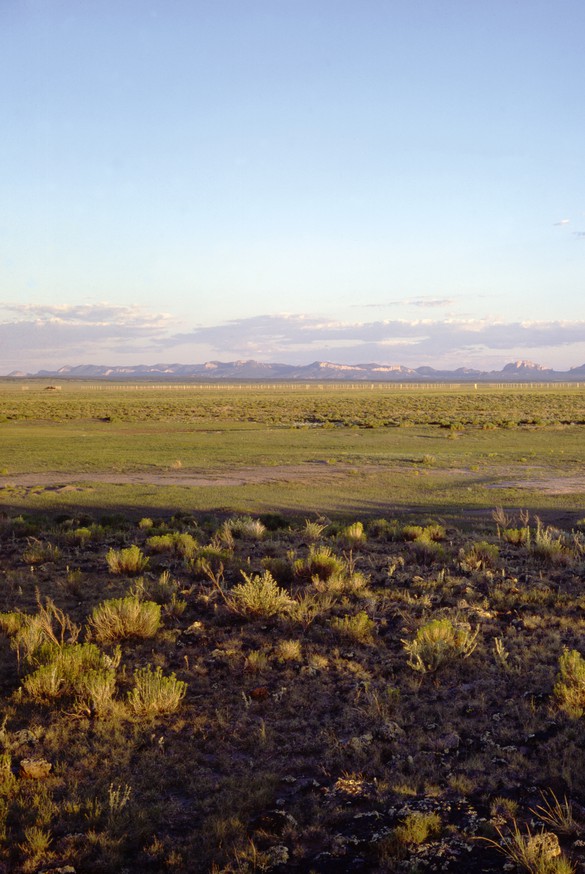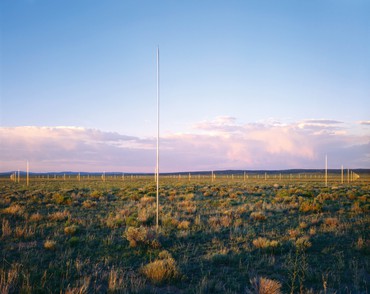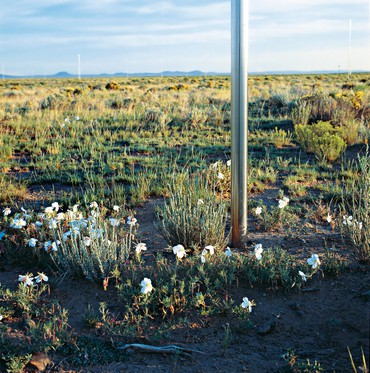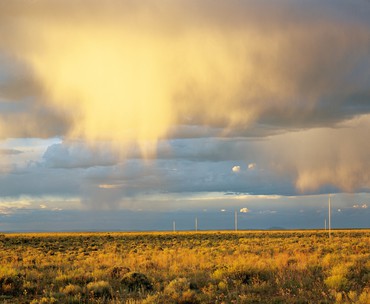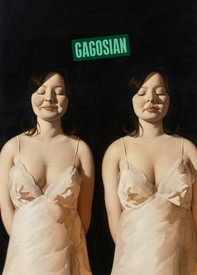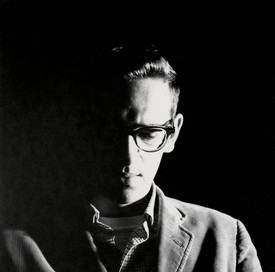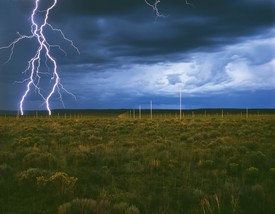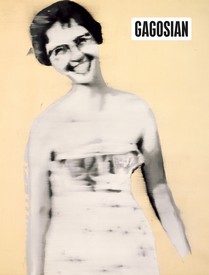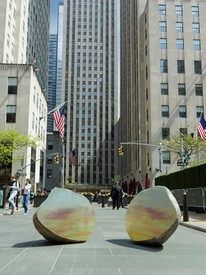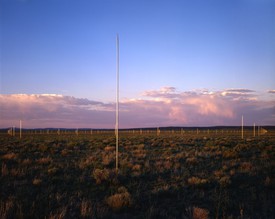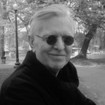
John Elderfield is chief curator emeritus of painting and sculpture at New York’s Museum of Modern Art and was formerly the inaugural Allen R. Adler, Class of 1967, Distinguished Curator and Lecturer at the Princeton University Art Museum. He joined Gagosian in 2012 as a senior curator for special exhibitions.
The uses of light are infinite in enabling us to walk, to ply our arts, to read, to recognize one another—and nevertheless the very beholding of the light is itself a more excellent and a fairer thing than all the uses of it.
—Francis Bacon, Novum Organum, 1620, Book 1, cxxix
The tiny four-block-long town of Quemado—population 228 in the 2010 census—lies on sleepy US Route 60 in Catron County, New Mexico, halfway between Pie Town and the Arizona border and about 150 miles southwest of Albuquerque. A small two-story white building across from the post office houses a branch of Dia Art Foundation, which commissioned and maintains Walter De Maria’s work The Lightning Field (1977) and arranges visits to it. Having made a reservation to do so, you will have been instructed to be at that building by no later than two in the afternoon on the day of your visit, as will all others of the maximum of six who are allowed to make appointments for the same viewing. From there, a usually muddy Dia Yukon truck will take you the forty-five-minute drive from paved to unpaved roads, across a scrubby, almost featureless landscape, and will drop you off behind the tiny log cabin there that preexisted the Field and at which you have committed to stay until noon the following day.1
“You may not take your own vehicle,” the Dia website informs you, as well as telling you that pets cannot accompany you, electronic devices must be left behind, photography is prohibited, and you must let them know if you have the temerity to be planning to bring young children along with you—all in keeping with the artist’s wishes.2 From this you will have learned that De Maria was a very controlling artist; he in fact sanctioned only six photographs to be published of The Lightning Field and kept secret its precise location.3 But you will not yet have learned that De Maria was also a very astute artist in making you wait for an unmediated experience of what the critic Kenneth Baker described in 1988 as “the closest thing to a masterpiece to come out of Minimalism.”4 I don’t think he needed the qualification.
The Lightning Field is commonly described as an example of land art, which, in turn, is commonly described as a movement in which landscape and the work of art are inextricably linked. Land art is commonly understood as created in protest against the perceived artificiality and commercialism of gallery and museum art; Wikipedia, as usual a font of knowledge on such things, has laconically observed, “Often earth moving equipment is involved.” In this case it wasn’t, although a lot of post-hole digging was; and anyway, none of this is of much help when you get out of the truck shortly before three in the afternoon. Ever since one of the most breathtaking of John Cliett’s photographs of the work with bolts of lightning in the sky above or beyond it appeared on the front cover of the Artforum of April 1980, that is what it has commonly been thought to look like; and while you hardly expect that scene to be awaiting you when arriving on a relatively calm day, you may well have seen on the Dia website other Cliett photographs showing panoramas of the Field bathed in dramatic light.5 But at first you may not see anything at all.
As you walk up to the cabin, however, trying to hold back your disappointment, a small number of poles slowly become visible beyond it. Only a small number, though. While the sun has already moved west, it is still high enough in the sky—and the daylight over the open desert landscape is still sufficiently dazzling—that, in the absence of shadows, it is all but impossible to register the highly polished stainless steel poles, except those near to you. De Maria anticipated this, writing in 1980, “During the mid-portion of the day, seventy to ninety percent of the poles become virtually invisible due to the high angle of the sun.”6 This was the first lesson he arranged for visitors: that vision is inhibited not only by an increase in the density of darkness, but also by an increase in the intensity of light.7 And conversely, that, if you wait, the invisible will become increasingly visible as the angle of the sun decreases.
There has to be a reason why De Maria sanctioned photographs of the site in a lightning storm while knowing that visitors upon arrival would not see anything spectacular. I think it was that he wanted to show drama in the views of the site mediated by photography, then cancel such spectacle in the initial unmediated experience of the work, one that reveals less before it reveals more.8 For what he has created is an experience that unfolds over time; a narrative for us to follow so that we become agents or catalysts in the work’s realization.9 The narrative has three parts, which we explore by looking while walking around the Field; and within it; and from a more or less fixed position outside it. I shall address these in turn.
Walking the Boundary
“A simple walk around the perimeter of the poles takes approximately two hours,” De Maria wrote in 1980, advocating it.10 To take that walk is akin to the old ceremony of walking the boundary, or beating the bounds, of a parish, showing what is outside it as well as what is within. Outside the Field is, well, nothing much. Undeveloped grasslands with patches of wildflowers surrounding it reach into the distance; hardly any built thing is to be seen—the close-to cabin, of course, but otherwise only a distant windmill or two, some barbed-wire fencing, perhaps a far-off road. This is a bare landscape, 11 1/2 miles east of the Continental Divide and 7,200 feet above sea level; at roughly the same latitude as Los Angeles and Tangier; and as bright as the latter, with as much as 14 1/2 hours of sunlight in the massive blue sky at the summer solstice. Further south of the site, mountains on the horizon are as difficult to see as the array of the poles, one of the ways in which the “outside” of the Field speaks to its “inside.”11 Another is that, walking the perimeter, you are conscious that the broken terrain, scrappy vegetation, and wide sky are no different to either side of the outermost rows of poles. And yet you know that a single step will take you within a space that is as unlike what is outside as like it. To enter that space is not like entering architecture, and not quite like walking into a forest—more like taking a step into a maze, except that you can see what awaits you inside.
The poles themselves are two inches in diameter, with precisely milled solid pointed tips that define a horizontal plane. In other words, although the ground on which they are sited is far from flat, their heights have been adjusted so that, as De Maria put it, the tops form a plane that theoretically could “support an imaginary sheet of glass.”12 The average height of the poles is 20 feet 7 1/2 inches; the shortest pole is 15 feet tall and the longest is 26 feet 9 inches. This huge variance will be unmistakable and vivid when you walk within the field, but is clear enough from the eighty-two poles that constitute the four outermost rows of the rectangular Field, and from those you can see immediately behind them.
It is impossible to count all of the poles, but walking the boundary we will be conscious of their multitude, spacing, and orientation. Dia does tell us that the Field comprises 400 poles spaced 220 feet apart from each other, which is getting on toward 2 1/2 times the length of a basketball court and just some forty feet short of a typical north-to-south New York City block. They are arranged in the form of an orthogonal grid aligned to the points of the compass: the rows running from east to west are twenty-five poles long, cumulatively measuring 5,280 feet, or one mile; those running from north to south are sixteen poles long, measuring 3,300 feet, or as close to one kilometer as is possible in combining the two systems of measurement. We notice, even from the outside, what critic John Beardsley calls “the inference of infinity.” He observes that “the poles stand in stately succession, uniform in height and in the distance between them. As they diminish in the distance, they create the illusion—like telephone poles or railroad tracks—of endless progression.”13 However, even from the outside this phenomenon is not simply seen but enacted. As another writer, Christopher D. Campbell, put it, we participate in “an exercise in movement and cessation”:
One moves to a vantage point and admires the perfect symmetry of the view down a single row, where as many as twenty-five poles stretching a mile into the distance are so perfectly aligned that twenty-four disappear behind the nearest one. One moves again to a midpoint between two rows to admire the diminishing perspective of the poles’ recession to the distance. Again, one moves to a point where diagonals intersect and both foregoing views are afforded with no more movement than a turn of the head.14
The poles are the material supports for the perceptual—and complementary corporeal—activities that De Maria programmed. The intrinsic meaning of this extraordinary work lies in the qualities of the experiences that we can derive from these activities while we look and walk within, even more than around, the Field in changing light and across rough and irregular terrain.
Within the Field
“The primary experience takes place within The Lightning Field,” De Maria wrote in 1980.15 The “primary experience” is the one first in importance, but is not a single most-important experience; in fact it is an accumulation of experiences large and small. These are at once visual and bodily, more evidently so within the Field than from outside it, because walking within it will involve the more complex variations in movement and cessation and, therefore, in the sights and accompanying, palpable sensations that they provide.
The shining poles are of a small, two-inch diameter—tiny in the context of the landscape, but their graspable size, viewed close up, provides a human dimension that grounds their more-than-human height. And if we do touch them—which we can, because we’re not looking at art in a museum—we will register the sliding precision of their surfaces, their changes in temperature throughout the day, and, if it is windy, a vibration faintly heard as well as felt. Moreover, the poles are effectively convex mirrors that close up produce a plausible, albeit distorted image of you while miniaturizing more distant features, making surrounding poles seem tiny and even further away than they actually are.
Judging their actual size and relative proximity, however, is often not easy. Their full height is perceptible by sight at a distance; less easily so the nearer we get to them and the lower our angle of view. To complicate matters, that full height is reduced proportionally when we view them from afar. They shrink in girth as well, reading as increasingly thin lines as they recede. We expect distant things to be smaller, so it is not a surprise to see the poles increasing or decreasing in height and girth in response to our moving toward or away from them. The photographs De Maria sanctioned were all taken from outside the Field, and therefore all show the poles only at reduced heights and girths, a reduction increasing as the camera moves away. He appears to have left it for us to discover the poles also enlarging with our proximity to them within the work, where, as he said, “the primary experience takes place.”
An additional factor, mentioned earlier, complicates our perception of the relationship between height and distance in our experience of the poles. In order to make their tips define a horizontal plane—as if they could “support an imaginary sheet of glass”—the literal heights of the poles had to be adjusted to compensate for the irregularity of the ground on which they were sited. The experience of walking within the Field includes consciousness of these literal variances, as well as of those virtual ones produced by seeing them receding in the distance. In fact, while looking down the length of a row of poles, you are very aware of their virtual changes in height; whereas when you approach them individually or in small groups, you are more conscious of their literal differences in height. This is because looking down a row of poles virtually condenses the spaces between them, making you more conscious of the imaginary sheet of glass joining their tips. Conversely, as you approach a pole close-up, you see it 220 feet apart from its neighbor, separately from the row; and the low angle of your view prevents you seeing its tip clearly. Both of these factors make you less conscious of it supporting an imaginary horizontal plane.
De Maria said that the idea for The Lightning Field came from sketches he made around 1960 of groupings of poles—in other words, from drawing.16 I said that the poles read as increasingly thin lines as they recede; and lines are fundamental to the practice of drawing, to which this work of De Maria’s may be said to belong. In drawing there are two basic forms of delineation, lines and borderlines. A line is a path, road, or river that runs across, into, over, or around something; a borderline is a contour, an occluding edge, a division between things or parts of things.17 Since nearly all of Cliett’s photographs of The Lightning Field are panoramas taken from “outside,” at a distance, we see the poles there as akin to spaced parallel lines drawn on a scroll reaching across the landscape. In the “primary experience” of walking “inside” the Field, we also see the poles isolated as individual lines, but not only so. They also form borderlines.
Campbell observed that it is possible to see a single row of twenty-five poles so perfectly aligned that twenty-four disappear behind the nearest one—until we move even slightly, when they spread into an aggregated band, then pull apart. Smaller numbers of poles too can be seen as overlapping. This is to say, we can see the poles both separately and clustered, as lines and as bunched borderlines. But there is a more important way in which we recognize borderlines in The Lightning Field: as Michael Baxandall explained, “the most basic and important operation in the act of visual perception is to locate the edges of things”—that is to say, to locate borderlines.18 The Field invites us to do so when the individual poles cluster virtually. It also, and more importantly, invites us to see the individual poles as borderlines marking the edges not of things, but of the putatively empty spaces between them and in the entirety around them, dividing spaces “inside” and “outside,” and beneath and above the invisible plane of glass. This is perhaps what De Maria meant when he said “the invisible is real.”19
The ground below you at The Lightning Field is visible and real, rough and irregular, teeming with life and with evidence of time past. You walk over clumps of grass and patches of clay; stretches of wildflowers; around animal holes and anthills some two feet high; through snail shells and occasional fossils, reminding you that you are walking on an ancient seabed. You may even see arrowheads and shards of pottery, reminding you that indigenous people inhabited these plains.20 And there are mounds and hollows, including a particularly large, deep, oval-shaped concavity in the southwestern corner of the field, distant from the cabin and easily missed if you don’t go carefully through the entire site. Picking your way through—for you do have to go slowly—you are aware of both the unruly layering of a Darwinian entangled bank, beneath your feet, and, in front of your eyes, a modern geometric order, industrially made. The experience is corporeal as well as optical, with the graspable size of the poles giving them something of a handstaff association as you move along.
As you do so, additional virtual phenomena complicate your journey. Within any square, the surrounding four poles seem close enough to mark limits and situate you.21 If you follow from one to the next down an avenue of poles, that holding experience is repeated and reinforced. It is a curious sensation, finding oneself locked within the space and the experience, freely so yet in a controlled manner. The 220-foot distance between poles and adjacent rows of them, however, is great enough to be difficult to distinguish from the larger intervals between them diagonally, so it is easy to stray outside an avenue. And when—not if—you do so, the grid warps out of its regular alignment into disorder: what appeared to be a centering, supporting experience is lost. The warp is enhanced by parallax, namely, the apparent lateral displacement in space of an observed object according to the observer’s position, proximate objects appearing to shift in position more quickly than distant ones. Therefore, as you move forward in the Field, you initiate movement in the location of the poles, and variation in their height and girth at the same time. This virtual mobility is at its most active deep within the Field, and especially so when you stray from the straight and narrow, finding it discomforting. But finding and losing a sense of symmetry and order within the work’s symmetry and order is integral to the narrative designed by De Maria for experience of The Lightning Field.22
Looking at the Field
Upon arrival at the site, we noticed that vision far into the Field was inhibited by the intensity of the light, and assumed, correctly, that features then invisible would become increasingly visible as the angle of the sun decreased. But perhaps we did not notice that the bright light inhibited perception of the color in the scene. Back in 1916, T. E. Lawrence—popularly known as Lawrence of Arabia—on entering the Red Sea port of Jeddah, at a similar latitude to The Lightning Field, wrote of how “the heat of Arabia came down like a drawn sword and struck us speechless. . . . The noon sun had, like moonlight, put to sleep the colors. There were only lights and shadow.”23 This is also true of The Lightning Field.
Conversely, color is awakened as the angle of the sun decreases. This begins to be apparent the longer you spend within the Field after your midafternoon arrival: by late afternoon, the western edges of the poles are becoming animated by warm light—starting to colorize, and shimmering as they do so. Within the Field, this further complicates the virtual mobility around you. The tips catch the light first, and sparkle; the poles develop shadows of increasing length; more of them become visible, and if you have not walked the boundary and seen the length of the work’s avenues, their number is a surprise. Overall, the more of them to be seen, and the more vividly light reaches them, the more complex and alive the Field becomes. Baker speaks of how the poles “turn from solid objects into beams of dazzling light that pierce the air like tones. The change suggests such an increase in energy around me that I can hardly believe it doesn’t disturb the wide silence of the plain.”24 The artist Terry Winters, one of those who aided De Maria in the work’s construction, experienced the Field as “a rich psychic territory . . . a space where the pulse of energy and electricity is felt.”25 Energy thus being made visible, the greater the temptation to go “outside” the Field again and look at it as a whole.
If you are lucky with a sunset, you will see . . . the totality of the Field appearing miraculously to sharpen in definition as the movement of the light down the poles gains momentum and they blaze with color.
The cabin where you will stay the night is located some 600 feet outside the northern edge of the grid and centered between its tenth and eleventh rows from the east; that is to say, just left of center. As a result, looking south at the Field from the porch of the cabin at the end of the day, there is a larger stretch of it at the west in front of you as, at dusk, the light of the setting sun gradually—and then more quickly, it seems—retreats in that direction. The distant mountains, not clearly visible in bright sunlight, pop into view as the light fades. If you are lucky with a sunset, you will see this dramatically reenacted immediately in front of you, the totality of the Field appearing miraculously to sharpen in definition as the movement of the light down the poles gains momentum and they blaze with color. The Lightning Field becomes visible as a panoramic whole for the first time, showing the mile-wide, kilometer-deep field in its totality, every single pole sharply defined and appearing to glow from within. You cannot help but realize how far you have traveled perceptually from your arrival, with most of the poles virtually invisible, to this utterly spectacular display of them all at the end of the day.
If you are especially lucky, there could be one more thing: as the sun drops to the horizon and the color becomes more intense, something utterly unexpected might happen and truly strike you speechless. Staring at the orange-red array, your vision can suddenly produce a complementary afterimage, the whole field switching at a blink to an equally vivid, shining green flash of light. It lasts only a second or two, then dusk puts the color to sleep.26
The fading of light on The Lightning Field would seem an appropriate ending for the narrative that De Maria has arranged for us. But there is a final chapter if we are wise enough to ask: if sunset is like this, what about sunrise? That question can only be answered by getting up in the dark, finding your way beyond the eastern perimeter of the Field, and waiting.
It is not true, as is commonly said, that it is darkest just before dawn. It is certainly coldest just before dawn, because the landscape has been cooling throughout the hours of darkness while the sun is below the horizon; but because the sun is furthest below the horizon midway between sunset and sunrise, midnight is the darkest hour. As dawn approaches, the acute night vision that our evolution provided for our survival allows us to experience quickly every faint change in the sky’s color within night’s darkness; more so than when the sky darkens in twilight and dusk, because our eyes have adapted to the daylight they’ve been in all day.27 We are therefore aware of the gradual lightening of the sky while the sun is still invisible below the horizon behind us, but are forced to wait before we see its effect on the poles.
Because the tips of the poles are tapered, when the sun does begin to appear above the horizon, their small, upward-facing portions catch the light first. Suddenly it switches on a straight line of shining dots on top of the closest, almost kilometer-long, row of sixteen poles. (We see all sixteen dots of light at once, which we might not if there were twenty-five; this may be why De Maria set the shorter length of the Field in this orientation.) Then, as light begins to move down the eastern surface of this first set of poles, the tips of the next row of poles jump out of the darkness to form a second, parallel line of dots of light. This repeats, and continues to repeat, until the effect of the sun is indistinguishable from light reflecting from the already illuminated poles. But well before this happens, the low sun behind us casts our own shadows onto the Field, but strangely elongated, almost as tall as the poles themselves, as if we were on stilts—not only viewers of The Lightning Field, but within it.28
Enough time will remain before the truck arrives to return you to Quemado for you to walk fully around the Field, or to explore within it—the poles eventually becoming almost as invisible as they had been the previous early afternoon. A famous poem tells us, “And the end of all our exploring / Will be to arrive where we started / and know the place for the first time.”29 Yes, but we know that we do not know it fully. One day of your life spent at The Lightning Field is only one day in the life of The Lightning Field; and the next one will not be precisely the same.
1One room with a double bed, two rooms with twin beds; a maximum of six people. Beware: when my wife and I first visited, our fellow guests were a group of initially boisterous old friends on a reunion.
2See www.diaart.org/visit/visit-our-locations-sites/walter-de-maria-the-lightning-field (accessed November 30, 2020).
3Photography of this work is the principal subject of Jessica Morgan, “The Field of Representation,” in Walter De Maria: The Lightning Field (New York: Dia Art Foundation, 2017), pp. 11–15, an indispensable publication that reproduces forty-two of John Cliett’s many hundreds of photographs of the work, pp. 23–107. Elizabeth Childress, director of the Walter De Maria Archives, informs me that she and Michael Childress, archivist there, made the preliminary selection for this publication, which Dia finalized. I am indebted to both for information used in the present essay. While De Maria authorized Dia to release only six of Cliett’s photographs, he himself included eight (not six, as Morgan writes in ibid., p. 13) in his “Some Facts, Notes, Data, Information, Statistics, and Statements,” Artforum 18, no. 8 (April 1980), pp. 52–59, which is reprinted in ibid., pp, 17–19 (the version cited in the notes below), albeit separated from its illustrations, which appear instead among the volume’s plates. These plates are followed by technical information on the creation of The Lightning Field, Cliett’s description of his photographic project, and a valuable chronology and bibliography. The latter comprises well over one hundred items, too many of which offer an account of visiting The Lightning Field for me to begin to make reference to them. I have therefore referred to as few as possible. Neither have I made reference to the wider issues raised by The Lightning Field discussed in many publications upon it, but I will refer to some of these in the second part of this essay, to follow in the Summer issue of the Quarterly. Kathleen Shields’s book An Essential Solitude: Walter De Maria’s The Lightning Field Revisited (New York: SNAP, 2020), an important volume, appeared after I had completed the present text, and I was only able to refer to it on three occasions, indicated in notes 5, 8, and 16 below.
4Kenneth Baker, Minimalism: Art of Circumstance (New York: Abbeville, 1988), p. 125.
5The first published photographs of the Field, chosen by De Maria for the Artforum issue cited above, comprised four (including the magazine’s cover) that show lightning, four that do not. The one-page article in small type that accompanied them contains ten statements that refer to lightning, thereby drawing attention to it (see De Maria, “Some Facts,” p. 19). Five of them do speak of its infrequency, most specifically remarking that lightning activity can be witnessed from the Field—i.e., often miles away—on sixty days a year and observed actually passing over the Field on approximately three of thirty days during the three-month period of primary lightning activity. This is a brilliant example of how statistical truth does not always give you a straightforward answer, as I have to presume De Maria knew, and those who skipped the small type and only studied the photographs were left assuming erroneously that lightning activity could be observed 50 percent of the time. The six photographs that De Maria approved for release by Dia include two that show lightning—still an optimistic lightning/not-lightning ratio—while the release he also approved, which may be found on the diaart.org page for The Lightning Field, skipped the statistics but included the disclaimer, “A full experience of The Lightning Field does not depend upon the occurrence of lightning.” (My emphasis.) Since writing this, I have learned that Dia’s addition of this statement to its published materials was controversial within the De Maria circle because it was so explicit. However, both Dia and De Maria were sufficiently concerned by the idea that many visitors would go to the Field expecting to see lightning, or would feel disappointed not to, that they replaced the website images of the work with lightning with ones without it. See Shields, An Essential Solitude, pp. 86, 162 n. 40. I am unaware of any record of how often lightning strikes the poles themselves. I will return to the subject of light versus lightning in the second part of this essay.
6De Maria, “Some Facts,” p. 18.
7This phenomenon has been noticed often, for example in Edmund Burke, A Philosophical Enquiry into the Origin of Our Ideas of the Sublime and Beautiful (1757, reprint ed. New York: Harper and Brothers, 1883), p. 102: “Extreme light, by overcoming the organs of sight, obliterates all objects, so as in its effect exactly to resemble darkness.”
8De Maria said, “No photograph, group of photographs or other recorded images can completely represent The Lightning Field.” De Maria, “Some Facts,” p. 19. As noted above, he selected eight of Cliett’s photographs to represent the work in Artforum in 1980. Since these are certainly dramatic, following the tradition of nature photography begun by National Geographic in the 1930s, it is worth noting that they could have been still more so: as Morgan notes, De Maria at one point imagined a big billboard in New York’s Grand Central Terminal, but it went unrealized. And the Artforum article, which contained what Cliett would remember in 2001 as “second-choice pictures,” came after De Maria canceled a deal with Life because, according to Cliett, he feared that that magazine’s presentation, which was to include what Cliett said were “even better pictures” and on which discussion had begun in 1978, would sensationalize the project. See Morgan, “The Field of Representation,” p. 13, citing Cliett in Jeffrey Kastner, “The God Effect: An Interview with John Cliett,” Cabinet, no. 3 (Summer 2001), p. 91. Elizabeth Childress, however, who worked as Cliett’s assistant, remembers differently, believing that a specific selection of images for Life was never made. (In any event, Life was struggling and that year went from weekly to monthly.) De Maria also rejected Cliett’s proposal of recording images of the individual poles over a long time period. “Such a project,” Cliett wrote in 1978, “would be oriented toward a series of photographs, each of which served as a portrait of an individual pole.” Ibid., citing Cliett, “Walter De Maria’s Lightning Field Image Recording Project Report,” November 6, 1978, Dia Foundation Archives. “Sadly, this endeavor never came to pass,” writes Morgan. Those who think otherwise would note that, if completed, this project would have produced dramatic views of the site not only unavailable to the first encounter with it but impossible to any visit except one in which a visitor stood before each of the four hundred poles. Since I wrote this essay, a new, fine discussion of the problem of photographic representation of the Field has appeared in Shields, An Essential Solitude, pp. 82–96.
9In 1968, the critic David Bourdon wrote presciently that “De Maria is after a deeper commitment on the part of the spectator, who is asked to become an agent or catalyst in the fulfillment of the work,” only to add, “the burden of response is placed not on the sculpture but on the spectator.” “Walter De Maria: The Singular Experience,” Art International, December 1968, p. 40. Better, I think, placed by the sculptor on the spectator.
10De Maria, “Some Facts,” p. 18.
11The mountains’ reduced visibility, while comparable to that produced by intense downward light, is caused by the bluish haze that so-called airlight produces with distance; during sunset they pop into view. See David K. Lynch and William Livingston, Color and Light in Nature (Cambridge: Cambridge University Press, 1995, 2nd ed. 2001), pp. 28–29.
12De Maria, “Some Facts,” p. 18.
13John Beardsley, Earthworks and Beyond: Contemporary Art in the Landscape (New York: Abbeville, 1984), p. 63. Whether knowingly or not, in speaking of infinity Beardsley notes what Burke identified as having “a tendency to fill the mind with that sort of delightful horror, which is the most genuine effect, and truest test of the sublime.” Burke, A Philosophical Enquiry, II, IX, p. 92. Beardsley also follows Burke’s understanding of the effect of extended succession: “a colonnade of uniform pillars planted in a right line,” where the image of each round pillar “increases . . . renews and enforces the impression” of the preceding one, “until the eye, long exercised in one particular way, cannot lose that object immediately; and being violently roused by this continued agitation, it presents the mind with a grand or sublime conception.” Ibid., IV, XIII, pp. 175–76. There will be more on the sublime in the second part of this essay.
14Christopher D. Campbell, “Walter De Maria’s Lightning Field and McCarthy’s Enigmatic Epilogue: ‘Y que clase de lugar es este?,’” The Cormac McCarthy Journal 2, no. 1 (Spring 2002), p. 52. Available online at www.cormacmccarthy.com/journal/PDFs/Campbell.pdf (accessed November 30, 2020).
15De Maria, “Some Facts,” p. 18.
16I learned of these sketches, and added this sentence to my essay after completing it, from Shields, An Essential Solitude, pp. 34–36, which illustrates one such work of c. 1961.
17I borrow here from my discussion of lines and borderlines in “Happenings (In the Silent World of the Painter),” in Mary Weatherford: I’ve Seen Gray Whales Go By, exh. cat. (New York: Gagosian, 2020), p. 32.
18Michael Baxandall, “The Perception of Riemenschneider,” in Julien Chapuis, Tilman Riemenschneider: Master Sculptor of the Late Middle Ages, exh. cat. (Washington, DC: National Gallery of Art, 2000), p. 86. He continues, “Our eyes register an array of light values and discontinuities, and our minds interpret these as the surfaces and edges of objects.” The literature on visual perception is enormous; a useful introduction to the subject is Irving Rock, Perception (New York: Scientific American Library, 1984). It has an extensive bibliography, as has Baxandall’s Shadows and Enlightenment (New Haven and London: Yale University Press, 1995), which, while concentrating on the role of shadows in our visual experience, has a lot to say about the fall of light itself.
19De Maria, “Some Facts,” p. 19.
20Terry Winters makes this point in “Field Work (for Hayden),” in Katherine Atkins and Kelly Kivland, eds., Artists on Walter De Maria (New York: Dia Art Foundation, 2017), p. 78.
21See Kenneth Baker, The Lightning Field (New Haven and London: Yale University Press, 2008), p. 16.
22In this respect, The Lightning Field constitutes what psychoanalyst Christopher Bollas calls a “transformational object.” See his The Shadow of the Object: Psychoanalysis of the Unthought Known (New York: Columbia University Press, 1987), pp. 14–29. I have drawn from his discussion with reference to aesthetic objects, pp. 30–39.
23T. E. Lawrence, Seven Pillars of Wisdom (1926, reprint ed. Mineola, NY: Dover, 2018), p. 45.
24Baker, The Lightning Field, p. 17.
25Winters, “Field Work,” p. 74.
26On the green flash, see Lynch and Livingston, Color and Light in Nature, pp. 49–52.
27See ibid., pp. 43–44.
28See ibid., pp. 7–10.
29T. S. Eliot, “Four Quartets: Little Gidding” V:27–29 (1942), a poem that begins with “A glare that is blindness in the early afternoon” (I:8).
Artwork © Estate of Walter De Maria; photos: John Cliett, courtesy Dia Art Foundation, New York, and © Estate of Walter De Maria
For part 2 of this two-part essay, see "Light and Lightning: Wonder-Reactions at Walter De Maria's The Lightning Field"
